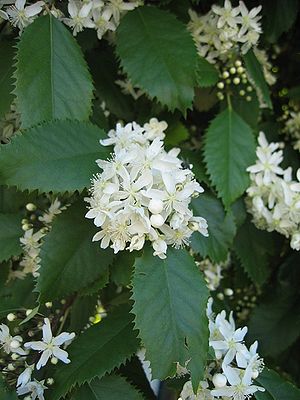Hoheria
| Hoheria | ||||||||||||
|---|---|---|---|---|---|---|---|---|---|---|---|---|

Inflorescences and leaves of Hoheria populnea |
||||||||||||
| Systematics | ||||||||||||
|
||||||||||||
| Scientific name | ||||||||||||
| Hoheria | ||||||||||||
| A. Cunn. |
Hoheria is a plant genus of the family of mallow (Malvaceae). All sixor sospecies occur only in New Zealand and the Kermadec Islands . The generic name Hoheria is a Latinization of the Māori name"Houhere" for these plants; this name as well as "Lacebark" and "Ribbonwood" are used as common names in the distributionarea. Since they bloom profusely, they areof interestas ornamental plants .
description


Hoheria species grow as evergreen, large shrubs or small trees that reach heights of 6 to 10 meters. The plant parts are sparsely to densely covered with star hairs ( trichomes ), especially when they are young. Young plants differ in terms of foliage and habit from the age form. The alternate arranged on the branches leaves are simple, oval or lanceolate with sawn or serrated blade edge.
In summer or autumn, many flowers are formed in lateral or sometimes terminal zymous inflorescences ; sometimes the flowers are solitary. There are no bracts. The hermaphroditic flowers are radial symmetry and five-fold with a double flower envelope . The five sepals are fused together in the shape of a bell or a cup; in addition to the five regular five calyx teeth, there are rarely other tiny calyx teeth. The five nailed petals are white and usually notched at the ends. In the subfamily Malvoideae, the many stamens have grown together to form a tube surrounding the pistil. In this genus, the stamen tube ends in five bundles of stamens. Five to fifteen carpels have grown together to form an ovary. Each carpel contains only one pendent ovule . The style ends in as many style branches as carpels. The scars are heady.
The dry capsule fruits do not open when ripe.
Systematics
Allan Cunningham established the genus Hoheria with the type species Hoheria populnea . The genus Hoheria belongs to the tribe Malveae in the subfamily of Malvoideae within the family of Malvaceae .
The genus Hoheria contains (three to) six species:
- Hoheria angustifolia Raoul : It thrives in lowland forests, especially on the edge of the forest on the north and south islands of New Zealand from latitude 39 ° south to the south.
- Hoheria equitum M. Heads : This species was only described in 2000 and occurs only on the Poor Knights Islands and the Hen and Chickens Islands off the north coast of New Zealand's North Island .
- Hoheria glabrata Sprague & Summerh. : It only occurs on the South Island of New Zealand.
- Hoheria lyallii Hook. f. : It thrives mostly from the mountain forest to the upper subalpine forest, often at the edge of the forest, only on the South Island of New Zealand from 41 ° 30 'to 45 ° south latitude.
- Hoheria populnea A. Cunn. : It is native to the North Island of New Zealand north of the 38 ° south latitude. It thrives in light forests of the lowlands and open land at altitudes between sea level and up to 460 meters.
- Hoheria sexstylosa Col .: It thrives in New Zealand from the lowland forests to the lower mountain forests, especially on the edge of the forest at latitude 36 ° 30 'south to the south.
use
Some species are cultivated as ornamental plants in New Zealand and Great Britain . Hoheria sexstylosa is hardy down to –15 ° C, and Hoheria glabrata is also frost-tolerant.
swell
- Flora of New Zealand : Hoheria . (Sections Description, Distribution and Systematics)
- Steven J. Wagstaff, Brian PJ Molloy, Jennifer A. Tate: Evolutionary significance of long-distance dispersal and hybridization in the New Zealand endemic genus Hoheria (Malvaceae). In: Australian Systematic Botany , Volume 23, 2010, pp. 112-130.
- Stewart Robert Hinsley: The Hoheria Page , last edited 2010. (Sections Description and Systematics)
Individual evidence
- ^ Hoheria in the Germplasm Resources Information Network (GRIN), USDA , ARS , National Genetic Resources Program. National Germplasm Resources Laboratory, Beltsville, Maryland.
- ↑ Michael Heads: A new species of Hoheria (Malvaceae) from the Poor Knights Islands and Hen and Chickens Islands , New Zealand, In: New Zealand Journal of Botany , Volume 38, 2000, pp. 373-377.
Web links
- B. Heenan, MI Dawson, DN Redmond, Steven J. Wagstaff: Relationships of the New Zealand mountain ribbonwoods (Hoheria glabrata and H. lyallii: Malvaceae), based on molecular and morphological data , In: New Zealand Journal of Botany , 2005, Volume 43, pp. 527-549. - abstract.
- Hoheria sexstylosa at Plants For A Future